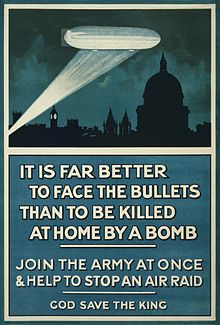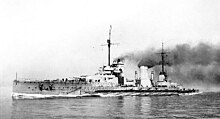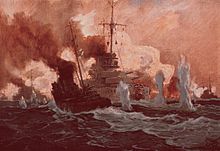
The Battle of Heligoland Bight was the first Anglo-German naval battle of the First World War, fought on 28 August 1914, between ships of the United Kingdom and Germany. The battle took place in the south-eastern North Sea, when the British attacked German patrols off the north-west German coast. The German High Seas Fleet was in harbour on the north German coast while the British Grand Fleet was out in the northern North Sea. Both sides engaged in long-distance sorties with cruisers and battlecruisers, with close reconnaissance of the area of sea near the German coast—the Heligoland Bight—by destroyer.

The Battle of Dogger Bank was a naval engagement during the First World War that took place on 24 January 1915 near the Dogger Bank in the North Sea, between squadrons of the British Grand Fleet and the Kaiserliche Marine. The British had intercepted and decoded German wireless transmissions, gaining advance knowledge that a German raiding squadron was heading for the Dogger Bank and ships of the Grand Fleet sailed to intercept the raiders.

SMS Lützow was the second Derfflinger-class battlecruiser built by the German Kaiserliche Marine before World War I. Ordered as a replacement for the old protected cruiser Kaiserin Augusta, Lützow was launched on 29 November 1913, but not completed until 1916. Lützow was a sister ship to Derfflinger from which she differed slightly in that she was armed with an additional pair of 15 cm (5.9 inch) secondary guns and had an additional watertight compartment in her hull. She was named in honor of the Prussian general Ludwig Adolf Wilhelm von Lützow who fought in the Napoleonic Wars.

HMS Lion was a battlecruiser built for the Royal Navy in the 1910s. She was the lead ship of her class, which were nicknamed the "Splendid Cats". They were significant improvements over their predecessors of the Indefatigable class in terms of speed, armament and armour. This was in response to the first German battlecruisers, the Moltke class, which were very much larger and more powerful than the first British battlecruisers, the Invincible class.

SMS Seydlitz was a battlecruiser of the German Kaiserliche Marine, built in Hamburg. She was ordered in 1910 and commissioned in May 1913, the fourth battlecruiser built for the High Seas Fleet. She was named after Friedrich Wilhelm von Seydlitz, a Prussian general during the reign of King Frederick the Great and the Seven Years' War. Seydlitz represented the culmination of the first generation of German battlecruisers, which had started with the Von der Tann in 1906 and continued with the pair of Moltke-class battlecruisers ordered in 1907 and 1908. Seydlitz featured several incremental improvements over the preceding designs, including a redesigned propulsion system and an improved armor layout. The ship was also significantly larger than her predecessors—at 24,988 metric tons, she was approximately 3,000 metric tons heavier than the Moltke-class ships.

SMS Derfflinger was a battlecruiser of the German Kaiserliche Marine built in the early 1910s during the Anglo-German naval arms race. She was the lead ship of her class of three ships; her sister ships were Lützow and Hindenburg. The Derfflinger-class battlecruisers were larger and featured significant improvements over the previous German battlecruisers, carrying larger guns in a more efficient superfiring arrangement. Derfflinger was armed with a main battery of eight 30.5 cm (12 in) guns, compared to the 28 cm (11 in) guns of earlier battlecruisers. She had a top speed of 26.5 knots and carried heavy protection, including a 30-centimeter (11.8 in) thick armored belt.

SMS Moltke was the lead ship of the Moltke-class battlecruisers of the German Imperial Navy, named after the 19th-century German Field Marshal Helmuth von Moltke. Commissioned on 30 September 1911, the ship was the second battlecruiser of the Imperial Navy. Moltke, along with her sister ship Goeben, was an enlarged version of the previous German battlecruiser design, Von der Tann, with increased armor protection and two more main guns in an additional turret. Compared to her British rivals—the Indefatigable class—Moltke and her sister Goeben were significantly larger and better armored.

SMS Von der Tann was the first battlecruiser built for the German Kaiserliche Marine, as well as Germany's first major turbine-powered warship. At the time of her construction, Von der Tann was the fastest dreadnought-type warship afloat, capable of reaching speeds in excess of 27 knots. She was designed in response to the British Invincible class. While the German design had slightly lighter guns—28 cm (11 in), compared to the 30.5 cm (12 in) Mark X mounted on the British ships—Von der Tann was faster and significantly better-armored. She set the precedent of German battlecruisers carrying much heavier armor than their British equivalents, albeit at the cost of smaller guns.

SMS Elbing was a light cruiser ordered by the Imperial Russian navy under the name Admiral Nevelskoy from the Schichau-Werke shipyard in Danzig in 1913. Following the outbreak of World War I, the ship was confiscated in August 1914 and launched on 21 November 1914 as SMS Elbing. She had one sister ship, Pillau, the lead ship of their class. The ship was commissioned into the High Seas Fleet in September 1915. She was armed with a main battery of eight 15 cm SK L/45 guns and had a top speed of 27.5 kn.

The Raid on Scarborough, Hartlepool and Whitby on 16 December 1914 was an attack by the Imperial German Navy on the British ports of Scarborough, Hartlepool, West Hartlepool and Whitby. The bombardments caused hundreds of civilian casualties and resulted in public outrage in Britain against the German Navy for the raid and the Royal Navy for failing to prevent it.

The fourth HMS Cleopatra was a C-class light cruiser of the Royal Navy that saw service during World War I and the Russian Civil War. She was part of the Caroline group of the C class.
SMS G41 was a 1913 Type Large Torpedo Boat of the Imperial German Navy during World War I, and the 17th ship of her class.

The Raid on Yarmouth, on 3 November 1914, was an attack by the Imperial German Navy on the British North Sea port and town of Great Yarmouth. German shells only landed on the beach causing little damage to the town, after German ships laying mines offshore were interrupted by British destroyers. The British submarine HMS D5 was sunk by a German mine as it was leaving harbour to attack the German ships. A German armoured cruiser was sunk after striking two German mines outside its home port.

The Harwich Force originally called Harwich Striking Force was a squadron of the Royal Navy, formed during the First World War and based in Harwich. It played a significant role in the war.

Franz Ritter von Hipper was an admiral in the German Imperial Navy. Franz von Hipper joined the German Navy in 1881 as an officer cadet. He commanded several torpedo boat units and served as watch officer aboard several warships, as well as Kaiser Wilhelm II's yacht SMY Hohenzollern. Hipper commanded several cruisers in the reconnaissance forces before being appointed commander of the I Scouting Group in October 1913.

The action of 19 August 1916 was one of two attempts in 1916 by the German High Seas Fleet to engage elements of the British Grand Fleet, following the mixed results of the Battle of Jutland, during the First World War. The lesson of Jutland for Germany had been the vital need for reconnaissance, to avoid the unexpected arrival of the Grand Fleet during a raid. Four Zeppelins were sent to scout the North Sea between Scotland and Norway for signs of British ships and four more scouted immediately ahead of German ships. Twenty-four German submarines kept watch off the English coast, in the southern North Sea and off the Dogger Bank.

HMS Nimrod was a Marksman-class flotilla leader of the British Royal Navy. She was built by the Scottish shipbuilder Denny, with construction starting in 1914 and completed in August 1915. She served through the remainder of the First World War. She was sold for scrap in 1921.
HMS Lightfoot was a Marksman-class flotilla leader of the British Royal Navy. Construction by J. Samuel White began in June 1914, shortly before the outbreak of the First World War, and the ship was launched and completed in 1915. She survived the war and was sold for scrap in 1921.
SMS S33 was a V25-class large torpedo boat of the Imperial German Navy that served during the First World War. She was built by the Schichau-Werke shipyard in Elbing, East Prussia, being launched on 4 April 1914 and was completed in October that year.

HMS Matchless was a Royal Navy Admiralty M-class destroyer. Matchless was built by Swan Hunter from 1913 to 1914 and was completed in December that year. She served through the remainder of the First World War, operating in the North Sea as part of the Harwich Force in the early part of the war and later in the English Channel as part of the Dover Patrol, where she took part in both the First and Second Ostend Raids. Despite being badly damaged by a German mine in 1915 and being involved in several collisions, she survived the war, and was sold for scrap in 1921.






















